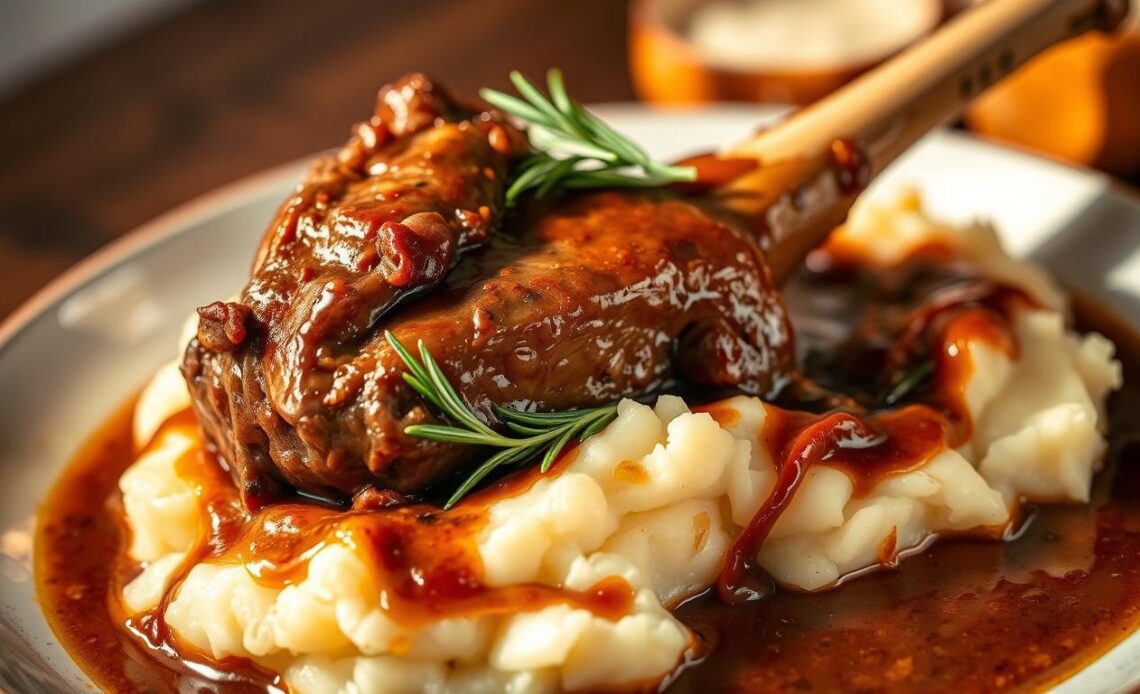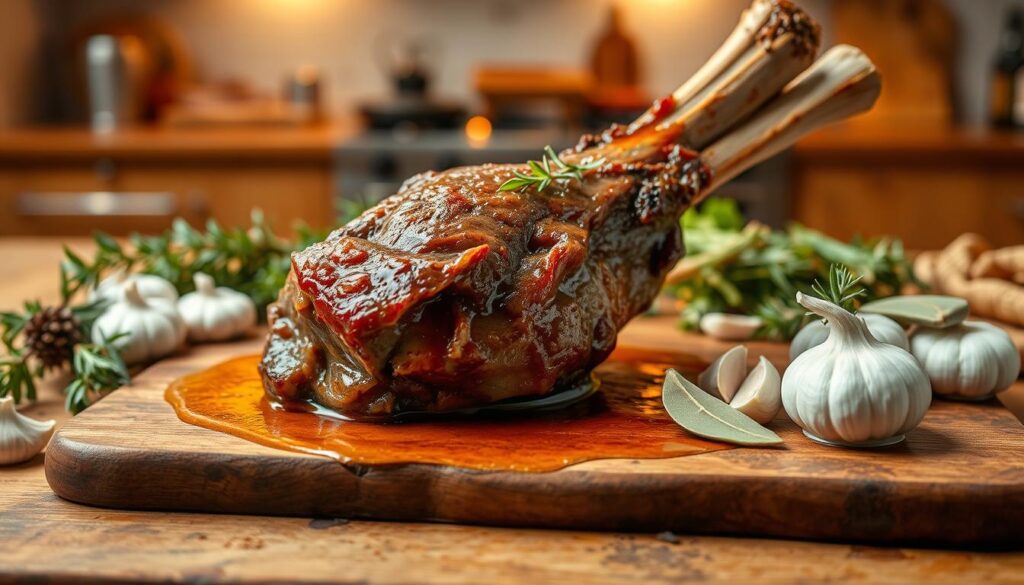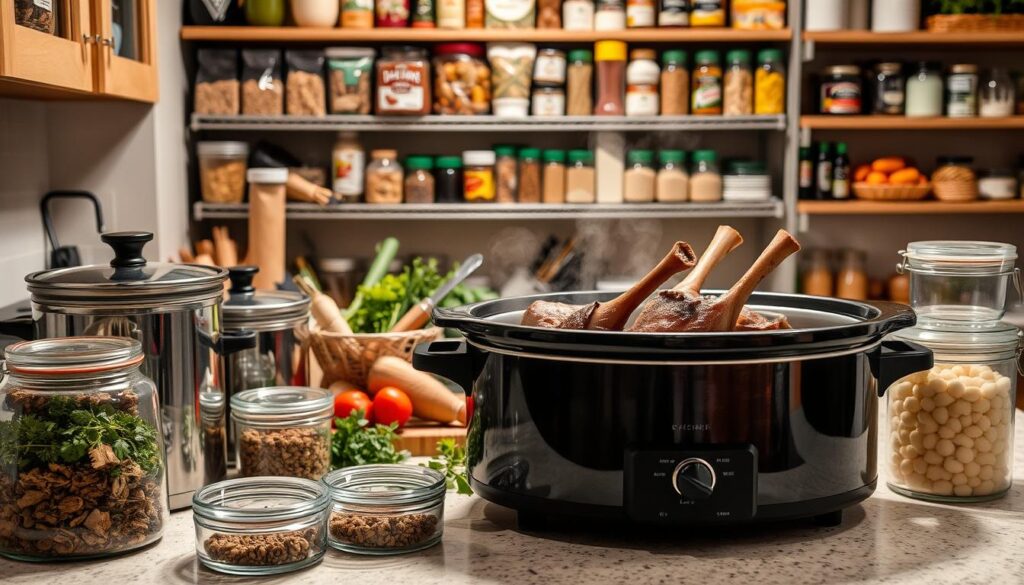
You know that warm, slow-simmered aroma that pulls everyone into the kitchen? That feeling matters. It turns a busy weeknight into a memory and makes guests pause with delight.
This is a cozy, restaurant-quality dish you can make at home. You start with a good sear to build deep flavor, then braise low and slow at 350°F (180°C) for about 2.5–3 hours until the meat slips from the bone.
Browned edges, aromatics, red wine, tomatoes and stock make a glossy sauce enriched by marrow. The method is forgiving: you can use the oven, stove, slow cooker or pressure cooker and still get tender results.
Follow a simple rhythm—sear, braise, rest—and you’ll end up with a silky sauce and a dish that feels special but is easy to repeat.
Key Takeaways
- Brown first, then braise low and slow for tender results.
- 350°F (180°C) for about 2.5–3 hours is a reliable timeline.
- Red wine, stock, and marrow create a spoon‑coating sauce.
- Method adapts to oven, slow cooker, stove, or pressure cooker.
- Serve over mashed potatoes, polenta, or risotto for comfort.
Why you’ll love this lamb shank meat recipe
You’ll get hands-off comfort and reliably tender results. Start by searing well to lock in flavor, then braise covered at 350°F (180°C) for about 2.5 hours. Finish uncovered to deepen the sauce.
Fall-off-the-bone tenderness with simple steps
One short sear, a low oven, and patient time turn a tough cut into something silky. If the pieces aren’t fork-tender when you check, add a splash of liquid and continue cooking until they yield easily.
Forgiving technique: why shanks are hard to overcook
Shanks thrive on long, gentle heat. You can run an hour or so over your plan and still keep the result succulent. That makes this an ideal dish for relaxed entertaining or a weekend cook.
- Brown first, then cover and let the oven do the work.
- Simple adjustments—more liquid or extra minutes—fix doneness without stress.
- The braise builds complexity, so your final dish tastes like it slow-cooked all day.
Ingredients that build deep flavor
The right base—onion, carrot, celery, and garlic—sets the stage for a rich braise.
Lamb shanks, aromatics, and the holy trinity
Start with your lamb shanks and the classic trio of onion, carrot, and celery to create a savory base. Add whole garlic cloves for sweetness and depth as the braise simmers.
Red wine vs. stock: choosing your braising liquid
For the fullest body, braise with 2–2.5 cups of full-bodied red wine (cabernet, merlot, or shiraz). Combine wine with low-sodium stock and crushed tomatoes so the sauce gains richness without tasting “winey.”
If you prefer no alcohol, use 1.5 cups low-sodium beef broth, 1 cup water, and 1 tablespoon Worcestershire for similar depth.
Herbs, spices, and tomato paste for body
Layer in tomato paste, fresh thyme, and bay leaves. Season early with measured salt and pepper, then adjust after reduction. A drizzle of olive oil at the start helps bloom aromatics and carry fat‑soluble flavor.
- Stir combine your liquids and paste before nestling in the shanks.
- Measure in cup quantities so balance stays consistent.
| Liquid | Quantity | Role |
|---|---|---|
| Red wine (cabernet/merlot/shiraz) | 2–2.5 cups | Adds body and complexity |
| Low-sodium stock | 1–1.5 cups | Supports savory depth without excess salt |
| Alcohol-free mix (beef broth + water) | 1.5 cups broth + 1 cup water + 1 tbsp Worcestershire | Beef-forward depth when skipping wine |
| Crushed tomatoes + tomato paste | 1–2 cups / 2 tbsp paste | Gives body and silky sauce texture |
Essential tools and prep for success
Choose your equipment and do tidy prep, and the rest of the cook will reward you. A heavy dutch oven keeps heat steady for even searing and a reliable braise. That steady heat creates the deep crust you want before the slow cook.
Why a heavy pot matters
Use a heavy dutch oven or similar pot for consistent heat, great browning, and a tight lid that limits evaporation. It also moves easily from stovetop to oven so you don’t change pans.
Trim, dry, and season for best results
Trim excess fat and any silver skin so pieces cook evenly and don’t tighten as they braise. Pat the surfaces dry to help them brown.
Lightly season with salt and pepper, then add a thin film of olive oil to encourage color without smoking. Sear lamb in batches so you don’t crowd the pot; work patiently and rotate to get color on all sides, then set aside while you build the aromatics.
| Tool | Purpose | Why it helps |
|---|---|---|
| Dutch oven | Even searing & braising | Holds steady heat; tight lid limits evaporation |
| Sharp knife | Trim fat and silver skin | Prevents tightening and uneven cooking |
| Oil (olive) | Encourage browning | Thin film reduces sticking and boosts crust |
Step-by-step: sear, braise, and sauce
A hot pan and a brief crust set the stage for a long, gentle oven finish that builds depth. Follow clear stages so each element does its job and the final plate tastes concentrated and balanced.
Sear over medium-high heat to develop a crust
Pat pieces dry and season. Heat the pot until it shimmers, then sear lamb shanks over medium-high heat for 3–5 minutes per side until deeply browned.
Work in batches so the pan stays hot. Set aside the browned pieces while you build the braise.
Build the braise with aromatics
Sauté onion and garlic cloves briefly, then add carrot and celery. Cook about 5 minutes until they soften and become sweet and translucent.
Deglaze, add broth and tomatoes
Deglaze with red wine and reduce by half, scraping up browned bits. Stir combine tomato paste into the reduced wine so it melts evenly.
Add crushed tomatoes, low-sodium broth (beef or chicken as you prefer), thyme, and bay leaves. Add just enough liquid so the shanks are mostly submerged but not swimming.
Braise in the oven, then finish the sauce
Return the shanks, bring to a simmer, cover, and transfer to the oven at 350°F for about 2 hours. Uncover for 30 minutes to tighten the sauce and deepen color.
When the pieces are fork-tender, set aside the meat. Strain the cooking liquid and reduce briefly to a glossy sauce, or blitz for a rustic, thicker finish. Taste and adjust pepper and salt only after reduction.
| Step | Timing | Purpose |
|---|---|---|
| Sear | 3–5 minutes per side | Develops crust and flavor |
| Sauté aromatics | ~5 minutes | Sweetens and builds base |
| Reduce wine | Until half | Concentrates flavor |
| Braise in oven | 2 hours covered + 30 minutes uncovered | Tenderizes and melds sauce |
Time, temperature, and doneness cues
A steady oven and a clear timeline help you trust the process and finish on schedule.
At 350°F (180°C), a 13–14 oz piece will usually become fork‑tender in about 2.5 hours. Allow up to 3 hours for larger or tighter pieces. If you prefer a hands-off route, plan about 8 hours on low in a slow cooker.
Cooking time guide: minutes and hours you can trust
For speed, pressure cook for roughly 40 minutes on high after a good sear. If pieces are not yielding, continue cooking and add a small cup splash of stock or water to keep the braise moist.
- Plan an oven braise at 350°F for ~2.5 hours, with wiggle room to 3 hours.
- Cover first to tenderize, then uncover to concentrate the sauce.
- Doneness is about feel: the meat should pull away from the bone and give easily to a fork.
“Check by touch, not the clock; the fork will tell you when it’s ready.”
| Method | Rough time | Note |
|---|---|---|
| Oven (350°F) | 2.5–3 hours | Cover then finish uncovered |
| Slow cooker (low) | ~8 hours | Hands-off; great for overnight prep |
| Pressure cooker | ~40 minutes | Start with sear for best color |
Let the dish rest briefly after cooking so juices redistribute. That small pause keeps pulls or slices moist and presents beautifully.
lamb shank meat recipe variations
Pick a flavor path—classic, alcohol-free, or spice-forward—and you’ll change the whole character of the braise.

Classic red wine and herb braise
Use cabernet, merlot, or shiraz with fresh thyme and bay leaves to build a deep, glossy sauce. The wine reduces to concentrate body and lift savory aromatics.
Choose a full-bodied red wine so reductions stay rounded and never harsh. Add cloves sparingly and finish with a pat of butter if you want silkier texture.
Alcohol-free option
If you avoid alcohol, stir combine 1.5 cups low‑sodium beef broth, 1 cup water, and 1 tbsp Worcestershire. This mix mimics wine’s savory backbone and keeps sauce rich.
Keep liquid levels similar to the classic path so the shanks remain mostly submerged and cook evenly.
Middle Eastern spice route
For warm, aromatic notes, bloom cardamom, turmeric, curry, cinnamon, and clove in olive oil with plenty of onions and garlic.
Add bay leaves, black pepper, and a pinch of Aleppo pepper. Finish with lemon juice to brighten and balance the spices.
- Maintain the same braising liquid volume across variations so cooking time stays consistent.
- Bloom spices in oil to unlock full flavor before adding the braising liquid.
- Swap rosemary or parsley stems into the classic path for a minor, pleasing change.
“Keep the technique steady—sear, braise, rest—and let your chosen braising liquid and spices define the mood.”
What to serve with your lamb shanks
A rich braise deserves a simple, sturdy side that soaks up every glossy spoonful.
Creamy mashed potatoes, polenta, or risotto
Spoon shanks and plenty of sauce over creamy mashed potatoes for a classic, comforting finish that soaks up the braising liquid.
Swap in parmesan risotto or soft polenta if you want a restaurant-style plate with a silky, starchy canvas.
Rice options that work
Lebanese vermicelli rice gives a nutty, toasty base that drinks up every drop of sauce.
Greek lemon rice adds a bright, citrusy lift that cuts through richness and lifts the overall flavor.
Fresh sides to balance the plate
Add peas or quickly sautéed spinach in a touch of olive oil for color and freshness.
A crisp fattoush or light Arabic salad brings acid, herbs, and crunch to balance the heavy food.
- Keep the plate simple: one hearty starch and one fresh side so the sauce stays central.
- If the sauce is very rich, offer a lemon wedge at the table to brighten each bite.
- Warm plates and crusty bread make the dish feel special and invite mopping the pan clean.
| Starch | Fresh Side | Why it works |
|---|---|---|
| Mashed potatoes / Polenta | Peas | Soaks sauce; adds sweet contrast |
| Parmesan risotto / Vermicelli rice | Fattoush / Arabic salad | Silky base; bright, crunchy balance |
| Greek lemon rice | Sautéed spinach (olive oil) | Citrus lift; leafy freshness |
Make-ahead, storage, and reheating
This braise is perfect for simple meal prep; flavors deepen overnight and the next-day plate often tastes better.

Do this right after cooling: keep each piece fully submerged in the sauce so it stays moist and protected while chilling.
Meal‑prep friendly: flavors improve overnight
Make the dish a day ahead and refrigerate. Overnight rest lets herbs, acids, and fat meld, which rounds harsh edges and builds depth.
How to store and reheat without drying the pieces
Chill 3–4 days in the fridge or freeze portions with sauce for up to 3 months. Before warming, skim any hardened fat from the surface for a cleaner finish.
To reheat in the oven, preheat to 350°F and place the pieces covered with a ladle of sauce for about 20–25 minutes so the center warms through without overcooking. For stovetop reheating, set the pieces in a saucepan with sauce and a splash of broth or water and warm gently over low heat.
If the sauce tastes sharp after resting, add a pinch of sugar or a little honey and simmer a few minutes until balanced. Build in a few extra minutes so reheating finishes gently and the texture stays tender.
- Keep portions submerged in sauce when you store them.
- Lift off the fat cap after chilling for a lighter taste.
- Set aside delicate sides and reheat them separately to preserve texture.
- A tiny drizzle of oil or fresh herbs at the end revives sheen and aroma.
| Storage method | Duration | Reheat tip |
|---|---|---|
| Refrigerate (in sauce) | 3–4 hours | Warm covered in oven or stovetop until hot |
| Freeze (portion with sauce) | Up to 3 months | Thaw overnight in fridge before gentle reheating |
| Quick stovetop | Minutes to warm | Add a splash of broth; low heat to avoid drying |
Pro tips and troubleshooting for perfect results
Nailing sear color and steady heat control prevents common problems and deepens overall flavor. With a few small moves you’ll keep pieces juicy and the sauce glossy.
Seasoning, searing, and managing the braising liquid
Salt lightly at the start so you can adjust after reduction. Brown the shanks well to give the sauce rich, savory notes that carry through the cook.
Keep the braising liquid at a low, steady simmer. Too much heat will tighten fibers and make the pieces tough.
- Build a deep crust while searing; it boosts overall flavor.
- Cook aromatics (onion, carrot, celery) until sweet to balance acidity.
- Finish with cracked pepper and a final check of salt before serving.
Fixing a thin, salty, or sour sauce
If the sauce is thin, simmer it uncovered for a few minutes until it reduces and thickens naturally.
For a too-salty finish, dilute with a splash of water or unsalted stock, then stir in a small knob of butter to round the taste.
If canned tomatoes make the sauce sharp, add a bit of honey or sugar and simmer for several minutes. Blitzing some cooked vegetables into the sauce also adds body and softens edges.
“Taste as you go—small adjustments make a big difference.”
Conclusion
A quick, hot sear followed by low, even oven time is the simplest path to effortless, fall-off-the-bone results.
Plan 2.5–3 hours at 350°F, sear first over medium-high heat, then braise until pieces ease from the bone. Strain and reduce the braising liquid for a glossy, balanced sauce that lifts the whole dish.
You’re set to serve this lamb shank with mashed potatoes, risotto, or polenta and a bright side like peas or sautéed spinach. Use the classic red wine path, the alcohol-free route, or a spice-forward variation to match your mood.
With clear cooking time and doneness cues, you can cook with confidence and enjoy food that tastes as good as it looks.

